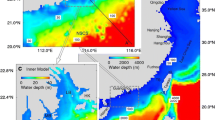Abstract
An MOM2 based 3-dimentional prognostic baroclinic Z-ordinate model was established to study the circulation in eastern China seas, considering the topography, inflow and outflow on the open boundary, wind stress, temperature and salinity exchange on the sea surface. The results were consistent with observation and showed that the Kuroshio intrudes in large scale into the East China Sea continental shelf East China, during which its water is exchanged ceaselessly with outer sea water along Ryukyu Island. The Tsushima Warm Current is derived from several sources, a branch of the Kuroshio, part of the Taiwan Warm Current, and Yellow Sea mixed water coming from the west of Cheju Island. The water from the west of Cheju Island contributes approximately 13% of the Isushima Warm Current total transport through the Korea Strait. The circulation in the Bohai Sea and Yellow Sea is basically cyclonic circulation, and is comprised of coastal currents and the Yellow Sea Warm Current. Besides simulation of the real circulation, numerical experiments were conducted to study the dynamic mechanism. The numerical experiments indicated that wind directly drives the East China Sea and Yellow Sea Coastal Currents, and strengthens the Korea Coastal Current and Yellow Sea Warm Current. In the no wind case, the kinetic energy of the coastal current area and main YSWC area is only 1% of that of the wind case. Numerical experiments also showed that the Tsushima Warm Current is of great importance to the formation of the Korea Coastal Current and Yellow Sea Warm Current.
Similar content being viewed by others
References
Fang, G. H., Z. X. Wei, Choi Byung-Ho, K. Wang, Y. Fang and W. Li, 2003. Interbasin freshwater, heat and salt transport through the boundaries of the East and South China Seas from a variable-grid global ocean circulation model.Science in China (Series D)46(2): 149–161. (in Chinese with English Abstract)
Fang, Y., Q. H. Zhang and G. H. Fang, 1997. A numerical study on the path and origin of the Yellow Sea Warm Current.The Yellow Sea 3(1/2): 18–26.
Guan, B. X., 1984. Summary of China Seas Circulation System and Structure. Report on the Ocean Research of Institute of Oceanology. Chinese Academy of Sciences. p. 116–141. (in Chinese)
Hellerman, S. and M. Rosenstein, 1983. Normal monthly wind stress over the world ocean with error estimates.J. Phy. Oceanogr. 13: 1093–1104.
Levitus, S. and T. P. Boyer, 1994. World Ocean Atlas, Washington DC: NOAA, p. 1–117.
Liu, X., 1996. Numerical simulation of the Yellow Sea wintertimem circulation.Oceanologia et Limnologia Sinica 27(5): 546–555. (in Chinese with English abstract)
Ma, Y., S. M. Xiu, H. S. Huang et al., 1999. A 3D baroclinic numerical model for winter circulation in Eash China Seas.J. Hydro. Ser. A 14(4B): 132–142. (in Chinese with English abstract)
Mask, A. C. and J. J. O'Brien, 1998. Wind-driven effects on the Yellow Sea Warm Curren.Journal of Geophysical Research 103(C13): 30713–30729.
Su, J. L., 2001. Research on the Dynamic Mechanism of China Seas.Acta Oceanologica Sinica 23(4): 1–16. (in Chinese)
Wang, W. and J. L. Su, 1987. A barotropic model for the current system and eddy in the Yellow Sea and East China.Acta Oceanologica Sinica 9(3): 271–284. (in Chinese)
Wang, H., 1995. Baroclinic Model of the Circulation of East China Sea and Yellow Sea,Acta Oceanologica Sinica,17(1): 21–26. (in Chinese)
Yuan, Y. C., J. L. Su and J. S. Zhao, 1982. One layer model of East China seas Shelf Circulation.Acta Oceanol. Sin. 4(1): 1–10. (in Chinese)
Yuan, Y. C. and J. L. Su, 1987a. 3D prognostic computation of East China Sea circulation in summer 1984, Kuroshio Research Corpus, Beijing, China Ocean Press. p. 45–53. (in Chinese)
Yuan, Y. C. and J. L. Su, 1987b. 3D prognostic computation of East China Sea circulation in winter during December 1984 and January 1985. Kuroshio Research Corpus, Beijing, China Ocean Press. p. 54–60. (in Chinese)
Zhu, Y. H. and G. H. Fang, 1994. A 3D barotropic model on shelf and shallow sea and application to Bohai Sea, Yellow Sea, East China Sea.Acta Oceanologica Sinica 16(6): 11–26. (in Chinese)
Author information
Authors and Affiliations
Corresponding author
Additional information
This study was supported by the Major State Basic Research Program (No.G1999043808), Youth Fund of the National 863 Project (No.G2002AA639350) and the Scientific Foundation of the Chinese Academy of Sciences (KZCX2-202).
Rights and permissions
About this article
Cite this article
Dong, H., Yijun, H., Zexun, W. et al. Study on numerical simulation and dynamic mechanism of winter-time circulation in the eastern China seas. Chin. J. Ocean. Limnol. 22, 327–334 (2004). https://doi.org/10.1007/BF02843625
Received:
Accepted:
Issue Date:
DOI: https://doi.org/10.1007/BF02843625



